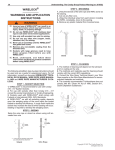Download Bringing Easy Video To The Classroom Teacher`s Guide
Transcript
Bringing Easy Video To The Classroom A practical guide to the effective use of video in education Featuring Corel VideoStudio® Pro Teacher’s Guide Includes: -Introducing video in the classroom -Pedagogical Advantages of video -How to use video effectively -Using the VideoStudio Student Guide -Evaluation techniques -Advice on managing classroom video -17 sample video projects Dear Reader, Get ready for a profound transformation. If you’re reading this, you probably already know that video has an amazing potential to inform, entertain and influence in a highly engaging way. And even though video is already big today, it is poised to become enormous in the years ahead. Video may soon be as central to the way we communicate online as the written word. With this guide and Corel’s accompanying student resources, our goal is to provide educators like you with the tools you need to equip students for a video-centric future. This teacher guide provides simple tools and projects that will give your students measurable video skills. Combined with the power, ease-of-use and creativity of Corel VideoStudio Pro, these materials will help students get started in video in mere minutes – literally. But this isn’t all Corel is doing to support video in education. As part of our commitment to our users, we are constantly working on new informative content and practical tools to help our users be successful. I encourage you to stay up-to-date with us via our website (www.corel.com/videostudio), our blog and template-trading site (www.photovideolife.com) or via Twitter (www.twitter.com/videostudio) or YouTube (http://www.youtube.com/videostudiopro). It is our hope that we can work with you to help today’s video students become tomorrow’s video successes! Sincerely, Greg Wood Product Marketing Manager, Video Corel Corporation 2 INTRODUCTION Multimedia, or Information Communication Technology (ICT), in the classroom has become commonplace in recent years. I.T. (Information Technology) within schools has traditionally been about data processing and programming. Even the ‘New Media’ technologies such as Web design and digital video have often been pigeonholed into specific subjects like I.T. and film and TV. There has been a major shift towards using information technology as the standard communications platform within schools, arming students with the real-world skills they will need when entering the workforce. Multimedia offers the potential to use these and many other information technologies within all subject areas and to even cut across the traditional curriculum in ways never before imagined. Multimedia provides teachers and students alike with new methods in which to develop core lesson content and encourage creativity within the everyday classroom. As a communications platform, Multimedia allows students and teachers alike to develop rich tasks and projects. Successful use of Multimedia in the classroom will promote content, communication and creativity skills. Multimedia or multiple media can include: Video Text Images Sound Animation Most of these media types are already used every day in the classroom as standalone teaching aids. ICT provides the glue in which to bring them together under a single umbrella, while adding a new dimension – interactivity. One of the key elements of multimedia is digital video and one of the easiest and yet most powerful consumer digital video editing applications available is Corel VideoStudio. 3 A PICTURE IS WORTH A THOUSAND WORDS If a picture is worth a thousand words, imagine the power of video delivering 25 (PAL) or 30 (NTSC) pictures per second! Video is becoming a preferred means of communication in all aspects of life. Video as a communications tool allows you to present more information in a shorter period of time than almost any other communications medium. Video is also an effective communications tool when used as a supplement to other forms of communication such as the printed word. Why do many of us watch the news each day as opposed to reading a newspaper? The reason is that video delivers the greatest amount of information in the shortest amount of time. In just 5 minutes of watching the news, you can obtain sufficient information to understand what is going on in the world. And if you wish to explore that news further, you can search specific information in a newspaper or even the Internet. The use of video within multimedia allows you to do the same. For example, imagine having your students create and narrate a video on the history of your school. This could include: Audio and/or video interviews with past principals, teachers and elders Old footage from VHS New footage shot on digital cameras Historical and recent photographs Scripted narration Themed music from the area – maybe even an original score from the music department A simple one minute video can add significant detail or emotion to a PowerPoint presentation. 4 Pedagogical Advantages Digital storytelling, when used as an integral part of the curriculum, has a number of proven benefits to teachers and students alike. 1. Added stimulus and re-enforcement The use of digital storytelling in the classroom can actively re-enforce more traditional teaching techniques and has the benefit of engaging all types of learners including visual, auditory and kinesthetic learners. Students of all ages relate well to video and the very nature of the medium allows you to use this technology to offer added stimulus to more traditional classroom activities. 2. Conceptual Understanding The use of video within the classroom can assist in providing a greater understanding and conceptual clarity. The processes involved and discussed in this guide relating to development of digital video projects are designed to help students develop a faster engagement with a topic and often a deeper understanding of ideas than traditional written texts alone can provide. 3. Development of Higher-order Thinking Working on a digital video storytelling project engages students in a range of processes from original conception through to the final production which encourages and develops higher-order thinking skills. The stages and processes involved in developing the project often involve problem solving and collaboration, while also assisting students to think logically and sequentially. This type of project also promotes analytical thinking skills, encouraging students to select information in a thoughtful, yet critical manner. These skills can then be transferred to other aspects of their learning. 5 4. Development of Communication Skills From the initial story writing through to the final production, students are given new impetus to develop written, verbal and expressive communication skills. The fact that their story will become a video adds momentum to the activity and encourages the student to consider methods with which the story may be communicated beyond the written word. 5. Creativity The use of multiple media encourages students to express themselves in ways that traditional learning techniques often cannot. The ability to animate a story using video, photos, images, music, voice and special effects allows students to develop creative thinking skills. 6. Ownership As the writer, producer and star of their production, students develop a greater sense of ownership and this, in turn, helps develop a greater sense of autonomy and independence. 7. Assessment Digital video and digital video editing are also very effective for assessment, self assessment and assessment for learning. This technology allows you to easily keep a record of student skills that would otherwise be quite difficult, such as the emotional, oral and interaction skills of a student. In addition to the above, teachers may re-purpose existing media to suit classroom activities and/or to deliver more traditional content in new and exciting ways that help engage students from a variety of different learning styles. In the digital world in which we live, it is increasingly important that these technologies are seamlessly incorporated into everyday learning patterns. 6 The use of video and images combined with a soundtrack (voice-over narration used to present facts and music used to evoke emotion) enables video to cover and explain complex issues in a relatively short amount of time. More importantly, digital video is proven to engage students in ways never before imagined, allowing students to combine video, images, music, narration and special effects within a single project. The teacher resources include: Important information on how to integrate video into your multimedia-based activities A guide to setting up your infrastructure to handle video in the classroom A range of project ideas for using digital video your classroom The guide also aims to cater to both primary and high school teachers and offers a range of projects suitable for all grades. We understand that multimedia should be relatively transparent to teaching. Very few teachers enjoy the luxury of being employed to specifically teach software. However, many teachers are increasingly expected to teach using software. This guide respects this fact and is designed to help make using digital video in your classroom an easy and enjoyable experience. 7 WHAT IS A DIGITAL PROJECT? Project-based learning is perhaps where multimedia is best used within the classroom. Project-based learning can, by its very definition, cover a whole range of learning activities. Project-based activities: Tend to focus more on student activity over an extended period of time than the traditional single subject-centered lesson environment. Can easily cut across the curriculum in ways that traditional subject-centered lessons cannot. Tend to be rich tasks involving a wide range of activities, resources and media types. Project-based learning also helps to reinforce core learning activities and relate them to the real world environment. Digital video is a great and absorbing basis for project-based multimedia, as a wellplanned digital video project can include a variety of tasks including: Script writing Storyboard development Use of a camera Graphic design Animation Audio capture and development Video editing Multimedia Web development And so much more Digital video can also act as a component of almost any other multimedia project. 8 CONTENT IS KING Content is King. When it comes to effective use of multimedia within education, content should always be placed on the highest pedestal. While multimedia within education provides teachers and students a range of new tools with which to communicate, it should never displace the real purpose for the technology – the reinforcement of learning. Have you ever created or been presented with a PowerPoint presentation that appears to have 27 fonts on every page, numerous clapping and zooming noises and more colors than an Austin Powers movie? Unfortunately this is the trap of using multimedia in the classroom. More time is spent on using special effects than in developing the core content of the project. The Student Guide is laid out in a way that encourages students to concentrate on content before anything else. As Content is King, Design is its Queen. Great content presented without thought to layout and design can often fail to communicate the message you intended. 9 Think about the processes in writing a book: 1. 2. 3. 4. 5. 6. 7. 8. Before you start writing, you need a plan or structure and a clear picture as to what the expected outcomes should be. You would consider the audience for which the book is intended and base your style of writing upon this. You would consider the desired design and overall layout of your materials. Only then would you start writing. Having finished the content, you would check it against your original plan of action and expected outcomes. You would then proofread and check the content for grammatical and spelling errors. On completion, the publisher would again proofread the materials and check it for copyright issues, etc. The publisher would then have the materials typeset in an attractive and easy to assimilate format. Special Effects are the King’s Adversary. Unfortunately many of these steps are skipped when creating multimedia, causing special effects and poor layout to overshadow content. Special effects effectively become the adversary of good content. The Project Brief and Student Guide encourage students to spend as much time on content and design as in the final production of the project. When developing a project for your class, it is important to start at the end point. Consider the outcome and then develop a plan that facilitates it. Firstly clearly discuss and understand the project brief. Help students understand that despite all the ‘toys’ they can use, that content is the foundation. 10 CONTENT Understand and discuss the Project Brief Prepare your Design Layout Develop your Script Create a Multimedia Storyboard Collate Library Materials Create a Video Storyboard Shoot and Capture Original Video Create Original Materials PRODUCTION Create your Video Create your PowerPoint Test Your Project Before ever opening VideoStudio, your students should have: Defined their audience Developed a script Created a storyboard Researched and collated most of the raw materials needed for the project This will not only ensure the student project is driven by content, but also ensure that they are prepared in advance for the activity of video editing. ACTION LEARNING Have your students develop a detailed project brief before commencing their project. This would include: 11 Project title Video style (genre) Target audience Duration of video (minutes) The goals and objectives of their video A description of the overall production For team projects, a listing of who will assume each of the key responsibilities A list of resources required and possibly a budget of costs associated with the production Their planned start and finish dates An estimated schedule detailing all the key stages of your production and showing how long the production will take USING THE STUDENT GUIDE The VideoStudio Student Guide materials have been designed to assist students to understand and explore the use of digital video editing on the PC in a project-based learning environment. The guide is based on ‘real-world’ experience in setting up and running student projects, at both primary and high school levels, using digital video as a core component of project-based learning. A successful digital project will include: Planning Research Content Creation Design Decision Making Collaboration By using the Student Guide materials in association with the Teacher materials, the VideoStudio video tutorials and the VideoStudio user manual, you will be ready to plan and execute a range of exciting multimedia projects featuring digital video. 12 Sample Project Brief The following Project Brief is designed to encourage a project-based approach to digital storytelling. By using this project, students will learn to use digital video as an engaging and exciting communications medium that may be incorporated into other tasks. The sample student brief has been designed to cater to all grade levels. You may choose to remove or modify any of the tasks included and adapt the duration of the video clip to suit your grade level. Project Brief Your client, Smogworth Travel Services is a small travel agency specializing in local travel. Due to the growth of their business, they have already successfully diversified into a range of travel solutions including international travel. They now wish to expand their business to become a nationally recognized provider of International Travel and Executive Vacations. However, they are in need of a ‘face lift’ in order to reach new markets. They have approached us to provide a marketing campaign for their business in order to assist them in meeting their new strategy. Tasks 13 Create a new name and image for the company Create a postcard montage for the company that reflects their new image that will be used in the video, within PowerPoint and as a sleeve for distribution of the video on DVD Create a 60-second promotional video for the company to use in TV and other forms of media advertising. Plan and include some original footage (video and/or images) Create an interactive video using menus for display at trade shows - DVD is the easiest format. Optionally - Create a self-running multimedia Presentation (in Microsoft PowerPoint or your preferred application) featuring the video you have created, for circulation on disc or Web Time allotted: 3 Weeks / 6 Lessons / Homework Learning Key learning Areas: Arts, English, Social Studies, Business Studies Learning Levels: Elementary, Middle School, High School Collaboration Students will work in small groups of between 2 and 5 Desired Outcomes The conceptualization of an idea The development of a story/script and narration The organization of a project via the use of storyboards Development of basic design principles An understanding of the basic building blocks in developing a project Creation of original materials including narration/voice-over for the video Creative use of media in the production of their video An understanding of interactive multimedia and links Assessment Assessment would be based upon how well the students met the desired outcomes within the timeframe allocated. This may include: 14 Quality of script including grammar and spelling Development of narration Organization skills in relation to development of a storyboard Understanding and application of basic design principles Thought process relating to the inclusion of original materials Creativity displayed in the development of the video clip Use of design and links within a multimedia presentation Ability to collaborate within a team Teacher Notes The complexity of this project can be modified to suit any grade. It can also be extended beyond the original brief to include additional curriculum areas. For example, the student may also be required to develop a project plan using a Gantt chart (Mathematics) and then develop a business plan and budget for the company (Business Studies). The business plan may require the use of statistics as to potential market share of the business following this marketing activity and/or an analysis of their competition (Mathematics / Business Studies). Students may also be encouraged to create original art and music (Arts). At a Primary School level, the project could be simplified to create a 1-minute slideshow based on a simple story. RESOURCES A PowerPoint presentation covering the basics of video editing is included in the Teacher Resources. 15 DEVELOPING CONTENT With almost any project incorporating video, there are 7 basic steps that you should encourage students to complete during the development of their project. These are: 1. Review existing materials If you are making a library of materials, including video, images and audio, available to students, then they should have an opportunity to review these before beginning their script. 2. Develop a project brief Have your students develop a project brief based upon your requirements, outlining their objectives, resources and schedule. In a team environment, this will also include details of who will do what. This helps students envision the project as a whole and ensures they understand the required outcomes. 3. Develop a story / script Step three is to produce a basic storyline and then develop a script from it. The script should be organized by scenes and include any narration that is required for the actors or narrator. There are two key types of script: Event Driven An event driven script is influenced by the video, images and audio available to the script writer. Many documentaries are event driven. Examples of an event driven script or storylines are often seen in wildlife documentaries. Obviously, you cannot get wildlife to perform to a storyline, so you would create your storyline based on the actions of the animals caught on video. 16 Story Driven A story driven script is based on an existing story. The video, images and audio are created specifically to meet the story’s requirements. Most dramas are story driven. Examples of a story driven scripts are seen in most Hollywood movies, where an existing story (book) is adapted into a screenplay (script) before anything else occurs. 4. Develop a storyboard Once the script is in the bag, your students will need to create a plan of action as to how the script will translate to video or multimedia. 5. Create a shopping list and compile materials Having completed the storyboard, the students will now have a scene-byscene action plan for creating their video. As each scene lists all video, images, audio and text required to complete the scene, students should compile these into a master list. The shopping list will also include details of any original content that has still to be generated. Once the shopping list is complete, students can organize their media to get ready to start editing. 6. 17 Generate original content The students will generate an original video, images or audio required to complete the storyboard. When shooting original video, students should be encouraged to create a video log which details who, when and what was recorded on the tape. 7. Self Assessment Last but not least, the students should be encouraged to self-assess their progress at each step of the way against a ‘rubric’ or self-assessment table you have provided. RESOURCES The following files are included in the Teacher Resources: Video Storyboard (in Microsoft Word and PDF Formats) Multimedia Storyboard (in Microsoft Word and PDF Formats) Video Log (in Microsoft Word and PDF Formats) Example GANT Chart (in Microsoft Excel and PDF formats) Example Self Assessment ‘Rubric’ (in Microsoft Word and PDF formats) \ 18 COPYRIGHT AND ASSETS One of the most common issues facing teachers when they kick off any multimedia project is copyright law and fair use. Copyright protects the rights of the owner of materials including but not limited to: Written Materials Video Audio Images Copyright law protects the rights of the owner of these materials covering any form of reproduction, distribution, pubic performance, display, transmission or modification of the original work. Basically, copyright law works on the simple premise that the owner of any piece of work deserves to be compensated for their creativity. This generally means that the use of other people’s creativity requires that permission is sought and a payment is made for its use. If you have ever ‘borrowed’ some photos from the Web for your PowerPoint show, incorporated some text from a book or Website in your lesson plan, or even copied a small segment of a video from any source, you are possibly in breach of copyright law. So what happens when a student wishes to use that latest Top 10 song in their video, and/or perhaps some footage from an old pre-recorded DVD or even a VHS tape, what should you do? 19 The copyright law in most countries allows for fair use. Fair use of copyrighted materials relates to the use of other materials for, amongst others: reporting, critical evaluation and within classroom instruction. Fair use of materials, however, should never divert income from the copyright owner. For instance, a school creates a 25th Anniversary multimedia project on DVD that they intend to sell to parents as a fundraiser. This then makes the project commercial and included materials (songs, etc.) could potentially impact on the earnings of a copyright owner. The golden rule, when you wish to use content other than your own, is to seek permission from the owner. Often, in an educational environment and for non-commercial use, copyright owners may either waive copyright or provide it at a reduced fee. Here are a few things you can do to avoid copyright hassles: 1. ACCESS COPYRIGHT-FREE MATERIALS There are a large range of materials available in the public domain or royalty-free available to educators. Seek these out and create a library of these on your network for your students to access and use. 20 The Web also offers a variety of sources of royalty-free materials. Some websites, such as Jamendo.com, will offer very high quality music for you to use royalty-free if your project is of non-commercial nature. Similarly, VideoStudio Pro X4 and VideoStudio Pro X5 include SmartSound autogenerated music which can be used royalty-free, with additional autogenerated soundtracks that can be purchased from SmartSound’s website. Other sites, such as premiumbeats.com, offer some high-quality royalty-free music for sale. 2. DEVELOP A COPYRIGHT POLICY FOR YOUR SCHOOL Develop and publish a copyright policy and fair-use statement for your school and ensure this is available to all teachers and students. 3. ASK PERMISSION When in doubt, always seek permission from the copyright holder for use of their materials and encourage students to do the same. RESOURCES A sample permission form is included with the Teacher Resources. 4. ACKNOWLEDGE THE COPYRIGHT HOLDER If you use copyrighted materials, regardless of whether you use these under the ‘Fair Use’ rule or have sought and gained permission for their use, always acknowledge the copyright holder or source in your finished project. ACTION LEARNING Provide a lesson on the importance of copyright. This could include having students request permission for the use of copyrighted materials and/or correctly acknowledging the copyright holder / source of materials they use. 21 22 STORAGE AND ACCESS CONSIDERATIONS One of the biggest and yet unforeseen issues with the growth of multimedia in the classroom is the amount of pure data that is created. Files = Storage = Hard Drive space So what should you do when you have possibly hundreds of students using the technology— especially when that technology is storage-gobbling HD video? Here are a few hints based on experience within a variety of schools. 1. Create a Library of Materials If your school is like so many others, you probably aren’t equipped to have a camera and PC for each student. This means your students are probably sharing cameras and PCs—potentially creating headaches and logjams when it comes to (a) capturing footage and (b) getting students to download/access their video as they search or fast-forward/reverse to access their content for their projects. (This has the potential to be a real time waster.). The Project Brief We suggest that once you have defined a project for your class, like the ‘Travel Promotion’ included in our Student Guide, you take the time to compile a range of suitable materials available for all students to use. How much you involve your students is up to you. 23 These materials would include media for which you have already obtained copyright permission to use, royalty-free media or materials that meet the ‘fair use’ rule. These should include: A library of generic video clips suitable for the project A library of generic images suitable for the project A library of audio clips suitable for the project Cont rary to common belief, providing a common library of media for students to use does not result in ‘sameness’. Rather, students use these materials to create unique productions featuring ‘stock’ materials. Rarely, if ever, during a class project will you find two productions that look or sound alike. Students should be encouraged to also include some original video footage that they have shot or located themselves. 24 2. Provide easy access to the library of media Your network is not a good place to store much of your ‘raw’ media. The reason is that video files can be relatively large and the last thing you want is for groups of students transferring large files up and down over the network at the same time. Therefore, we recommend you organize your resources in on a resource CD, DVD, portable hard drive or USB Stick. Create a series of media with the various media types and then make multiple copies of these for students to borrow as needed. Clearly label the discs/media and provide an index to each on the network. The index to materials could be similar to that shown in the Appendix and can be provided as a spreadsheet via your network or intranet. You would end up with a range of discs including: Video Files Image Files Audio Files Students would simply load the files from disc to the PC as needed. 25 3. Provide students access to the hard drive (and a CD-ROM/DVD Drive) Digital video editing demands that you provide students access to a local hard drive on their systems. You cannot do video editing over the network. The files are simply too large and the data transfer rates available on the network are generally insufficient. As many schools ‘lock-down’ the c: drive as part of their security, this is something that will need to be discussed with the network administrator. The preferred solution is to provide a 2nd hard drive to the systems (d: drive) dedicated for multimedia projects. 4. Provide an easy method for students to transport files It is important to provide students an easy method in which to save and transport their files from one location to another. There are many possible solutions to this including the use of Flash Memory or portable hard drives. 26 USB Drives USB Drives can offer a convenient method with which to save project files. USB Drives are a type of flash memory that acts like a portable hard drive when connected into your USB port. Yet they are small enough to slip into your pocket or even hang around your neck. The major benefit of USB Drives is that they are a plug-and-play device and allow easy transfer of data from one PC to another. USB Drives are available in storage capacities anywhere from 500MB all the way up to 128GB or more all the way up to hundreds of GB. Flash Memory Flash memory is the type of storage media used in digital cameras, MP3 players and PDAs (person digital assistant). These days many digital video cameras also include flash memory to allow the video camera to double as a still image camera. Flash memory has many advantages as a storage medium. Many flash memory types are not much bigger than a postage stamp and yet offer storage capacities of up to 32GB. 27 Portable Hard Drives Another simple yet powerful storage device is to purchase one or more portable hard drives for use within your lab. External hard drives are available in capacities up to 2TB and are available with either USB 2.0 or above. Due to cost, portable hard drives are generally not something you can equip all students with. However, on a $ per MB basis, portable hard drives are by far the lowest cost solution for local portable mass storage. They are useful for saving class projects or acting as a storage device holding multiple students’ work locally. Portable hard drives allow direct video capture and are able to transfer huge files in a matter of seconds, making them by far the fastest solution. When selecting a hard drive ensure it offers 7200 rpm transfer. 28 5. Using SmartPackage SmartPackage is a great way to ensure students successfully save their project and associated media in a single place for access again later on an alternate classroom or home computer. Instead of simply saving the project file, SmartPackage packages all the files up into a folder or Zip file so they can be retrieved easily later. Simply select SmartPackage from the File menu, provide the project a name if not already named, and select a save location in either a folder or Zip file format. This is superb for saving to USB sticks or Network drive, so the student has all the files needed to continue editing their project. 29 UNDERSTANDING THE INTERFACE When you launch VideoStudio Pro X4 or VideoStudio Pro X5, you will see the Corel Guide. This helpful component of VideoStudio Pro contains information and content that will help you be more successful with VideoStudio. It’s a great place to explore the many features of the product and review video tutorials on how many of the features work. When you open VideoStudio, you will see the above ‘pop-up’ screen (unless it has been disabled by the School Network Administrator or yourself). The Corel Guide is an important screen. It is ‘live’ from the web and is constantly updated. The three key elements are: 30 1. Home / Learn / Do More / Messages This menu provides you access to a realm of video tutorials and important information to make you proficient with VideoStudio. It also provides access to downloadable new movie styles, fonts, music and templates etc. 2. What’s New in VideoStudio This overview video provides direct access to a VideoStudio Pro introductory video to show you some of what’s possible with the latest version. We suggest you review all the training videos available as they provide an excellent introduction to the major features of VideoStudio. 3. Do not display on startup If you click this, this screen will no longer appear unless it has been selected as default in your school’s start-up. To open the window again, select the icon on top right of window: To review the major edit interface features, please refer to the Student Guide materials. 31 EVALUATION AND ASSESSMENT One of the biggest issues facing teachers in the 21st century is just how to evaluate ‘multimedia’ content developed by students. Digital video editing is very similar to cooking, in that two or more videos that look the same on the outside, may, in fact, involve many different ingredients and processes during their development. Therefore it is important that all teachers, regardless of their personal ‘video editing skills’, understand the ingredients available and the processes involved in creating the final product. One common method of evaluation and assessment is the rubric. A rubric is, basically, a guideline for student performance and evaluation. The term rubric comes from the Latin term rubrica that means “red earth”. It came to mean that anything in red ink provided an authoritative rule or direction. These days within education circles, the term rubric generally refers to an evaluation table that outlines the expectations of the student and clearly outlines the various ‘grade’ levels associated with a number of key tasks or performance indicators. An effective rubric should allow the student to ‘self evaluate’ themselves during the development of their work. 32 Example Rubric for a Digital Video Project ACTIVITY Exemplary Proficient Sufficient Insufficient Points 10 Points 5 Points 3 Points 1 point Script Content Content is clear and concise with a logical progression of ideas and supporting information. Content offers a logical progression of ideas and supporting information. Content is vague and does not effectively deliver the message. Content lacks a clear message and logical sequence of information. Grammar and Spelling No errors in grammar or spelling. Several errors in spelling and grammar that do not, however, distract the reader from the content. Errors in spelling and grammar that distract the reader from the content. Multiple errors in spelling and grammar that make the content difficult to comprehend. Storyboard The storyboard clearly follows the script identifying the flow of the story. The storyboard follows the script identifying the structure of the video. The storyboard differs from the script, although is still possible to follow The storyboard does not follow the script and is difficult to follow. Content Identification The storyboard clearly identifies the content required. The storyboard follows the script identifying the structure of the video. The storyboard follows the script but does not identify the structure of the video. The storyboard fails to follow the script. Content Research The student has carefully researched and selected suitable content that matches that identified within the storyboard. The student has researched and selected content that matches that identified within the storyboard. The student researched and selected content that mostly matches that identified within the storyboard. The student has not researched and selected suitable content that matches that identified within the storyboard. Content Selection All of the content used clearly enhances the story/script and assists in illustrating the overall video. Most of the content used clearly enhances the story/script and assists in illustrating the overall video. Most of the content used clearly supports and assists delivering a message. Use of content is inappropriate or distracts the reader from the message of the video. Development SUB TOTAL - continued over page 33 POINTS ACTIVITY Exemplary Proficient Sufficient Insufficient Copyright and Fair-Use of materials Fair use guidelines are followed and all non-original materials are acknowledged. Fair use guidelines are frequently followed and most non-original materials are acknowledged. Fair use guidelines are sometimes followed and some non-original materials are acknowledged. Fair use guidelines are not followed. Non-original material rarely acknowledged. Understanding of Video Production The finished video displays an excellent understanding of storytelling via the medium of digital video. The finished video displays a good understanding of storytelling via the medium of digital video. The finished video displays a level of understanding of storytelling via the medium of digital video. The finished video does not clearly display an understanding of storytelling via the medium of digital video. Use of special effects within the video The finished video demonstrates careful selection of the various special effects available to assist in telling a story. The finished video demonstrates an understanding of the various special effects available to assist in telling a story. The finished video selectively uses special effects to assist in telling the story. Use of special effects is often inappropriate to the story and distracts the viewer from the actual message of the video. Use of audio within the video The finished video demonstrates an excellent understanding of how audio (narration, music, sound effects) can be used to assist in telling a story. The finished video demonstrates an understanding of how audio (narration, music, sound effects) can be used to assist in telling a story. The finished video uses audio effectively (narration, music, sound effects) to assist in telling a story. Use of audio is often inappropriate to the story and distracts the viewer from the actual message of the video. Overall The finished video meets the exact project requirements in terms of story, storyboarding, effective use of media and duration. The finished video meets the broad project requirements in terms of story, storyboarding, effective use of media and duration. The finished video demonstrates an understanding of the project requirements in terms of story, storyboarding, effective use of media and duration. The finished video does not demonstrate an understanding of the project requirements in terms of story, storyboarding, effective use of media and duration. POINTS TOTAL POINTS From the above table, you would then set your grading levels based upon meeting the criteria shown. 34 PROJECT IDEAS FOR USE IN THE CLASSROOM There are so many ways in which you use video to enhance a lesson or project. Digital video editing can be used in the classroom in variety of exciting ways that bridge the traditional curriculum. These days video editing is literally child’s play and when it comes to technologies like digital video editing, students are like sponges absorbing every element of this exciting technology and the many ideas that it can generate. The following project ideas are not designed to offer the definitive guide to using digital video in a classroom environment. Rather they are designed to whet your appetite and help stimulate additional ideas of the many ways you and your students may enjoy and benefit from using this amazing technology as a standard reinforcement tool for encouraging and engaging the learning process. Enjoy. 35 SHOW AND TELL Project Brief To create a show and tell video slideshow using digital images acquired from a digital camera Tasks Acquire and collate a collection of digital images. Develop a simple storyboard of these within Corel VideoStudio Instant Movie Select a suitable template for the storyboard. Select suitable music for the slideshow. Export the slideshow as a video file for insertion into PowerPoint. Time allotted 1 Lesson Learning Key Learning Areas: All Learning Levels: Elementary, Middle School, High School Collaboration Students can work individually or small groups of between 2 and 5. Desired Outcomes The conceptualization of an idea The development of a story/script and narration An understanding of digital media types An understanding of the video storyboard The organization of a project Assessment 36 Ability to organize digital media Ability to create a short video slip suitable for use within a Multimedia Project Optionally - ability to collaborate within a team Teacher Notes This is a very simple activity designed to introduce students to the concepts of digital video editing and may be used at any grade level. 37 SHOW AND TELL Project Brief You will assume the role of interviewer and interviewee in this special interview with yourself. First, develop a series of questions to ask yourself and then prepare a series of answers. You will first interview yourself asking the questions. You will subsequently video yourself against a green screen answering the questions. Using VideoStudio’s Green Screen (Chroma Key) feature you will composite both videos together into a single shot featuring an interesting video of you interviewing yourself. Tasks Develop a script providing both questions and answers about yourself Use a Green Screen to video yourself once as the interviewer and again and the interviewee. Use VideoStudio to composite the two shots into a single scene. Time allotted 1 Week / 3 Lessons Learning Key Learning Areas: Arts, English, Social Studies Learning Levels: Elementary, Middle School, High School Collaboration Students will work individually or in teams of two exchanging the roles of camera person and interviewer/interviewee. Desired Outcomes 38 The conceptualization of an idea The development of a story/script and narration The development of an interview Creative use of media in the production of their video Assessment Quality of interview including grammar and spelling Development of narration and a demonstration of public speaking skills Creativity displayed in the development of the video clip Teacher Notes The complexity of this project can be modified to suit any grade. The resulting video could be used within a multimedia presentation, uploaded to a video sharing site or interactive DVD. This lesson plan is designed to explore creative ideas for using blue screen technology within the classroom. 39 PRODUCING A NEWS BROADCAST Project Brief Your team includes a news reporter, a TV station manager, and an anchor person. You will collectively produce a news broadcast based on a newsworthy event that has happened in your school or community. Tasks Research and develop a news story. Develop a script for the anchor person. Interview one or more persons for the news story. Create a short news video on the story. Incorporate the news story into a second video featuring the anchor person. Produce the news broadcast as an interactive DVD or share on-line. Time allotted 1 Week / 3 Lessons / Homework Learning Key Learning Areas: Arts, English, Social Studies Learning Levels: Elementary, Middle School, High School Collaboration Students will work in small groups of between 2 and 5. Desired Outcomes 40 The conceptualization of an idea The development of a story/script and narration The organization of a project Development of basic design principles Creation of original materials including narration/voice-over for the video Creative use of media in the production of their video Assessment Quality of script including grammar and spelling Development of narration and a demonstration of public speaking skills Organization skills in relation to the storyboard Understanding and application of basic design principles Thought process relating to the inclusion of original materials Creativity displayed in the development of the video clip Use of design and links within a multimedia presentation Ability to collaborate within a team Teacher Notes The complexity of this project can be modified to suit any grade. The resulting video could be used within a multimedia presentation, uploaded to a video sharing site or interactive DVD. The news broadcast style ‘picture in picture’ effects will be created using the Overlay feature of VideoStudio. 41 ALL ABOUT PASTA Project Brief You are required to create a multimedia resource all about pasta. This will include a video on how pasta is made and a multimedia presentation on the geographical and historical background of the various types of pasta featured. You should also include nutritional information on pasta and a variety of recipes. Tasks Develop a script and storyboard for both a video and a multimedia presentation. Create a short video showing how pasta is made. Provide detailed information on the various types of pasta. Research and provide geographical and historical information for the origin of each major type of pasta. Present this information in an interactive multimedia presentation. Develop an interactive DVD for playback on TV. Time allotted 3 Weeks / 6 Lessons / Homework Learning Key Learning Areas: Arts, English, Home Economics, History, Geography Learning Levels: Middle School, High School Collaboration Students will work in groups of 2-5 Desired Outcomes 42 Demonstrated knowledge of how to make pasta Research showing knowledge of history and geography The development of a story/script and narration The organization of a project Development of basic design principles Creation of original materials including narration/voice-over for the video Creative use of media in the production of their video Assessment Quality of script including grammar and spelling Development of narration Organization skills in relation to the storyboard Understanding and application of basic design principles Thought process relating to the inclusion of original materials Creativity displayed in the development of the video clip Use of design and links within a multimedia presentation Ability to collaborate within a team Teacher Notes The complexity of this project can be modified to suit any grade. 43 AN INTERACTIVE HISTORY OF THE SCHOOL (DVD) Project Brief You are tasked with creating an interactive history of the school and local community. This should include historical information relating to the establishment of the school, previous principals, teachers and students, plus major events that have affected and influenced the school’s development. The history should be shown using a chronological approach. Tasks Interview local elders and past students or teachers using video or audio. Create a chronological history of the school showing key events in its development. Develop a short documentary video including images, video and interviews. Develop an interactive DVD including video, images and audio. Time allotted 6 Weeks / 9 Lessons / Homework Learning Key Learning Areas: Arts, English, History Learning Levels: Elementary, Middle School, High School Collaboration Students will work in groups of around 5 persons per team. Desired Outcomes 44 The conceptualization of an idea The development of a story/script and narration The organization of a project Development of basic design principles Creation of original materials including narration/voice-over for the video Creative use of media in the production of their video Assessment Quality of script including grammar and spelling Development of a chronological history Organization skills in relation to developing a storyboard Understanding and application of basic design principles Thought process relating to the inclusion of original materials Creativity displayed in the development of the video clip Use of design and links within a an interactive DVD presentation Ability to collaborate within a team Teacher Notes The complexity of this project can be modified to suit any grade. 45 CREATING A VIDEO GREETING CARD Project Brief You will develop a multimedia greeting card suitable to celebrate a seasonal, religious- or cultural holiday or a National Day The greeting card will feature a video clip. Tasks Develop a short story for your video clip. Prepare original materials including images and audio. Narrate the video clip. Incorporate the video clip into a self-running multimedia presentation. Time allotted 1 Week / 3 Lessons Learning Key Learning Areas: Arts, English, Social Studies Learning Levels: Elementary Collaboration Class Exercise Desired Outcomes 46 The conceptualization of an idea The development of a story/script and narration The organization of a project Development of basic design principles Creation of original materials including narration/voice-over for the video Creative use of media in the production of their video Assessment Quality of script including grammar and spelling Development of narration Organization skills in relation to the storyboard Understanding and application of basic design principles Thought process relating to the inclusion of original materials Creativity displayed in the development of the video clip Use of design and links within a multimedia presentation Ability to collaborate within a team Teacher Notes This project can be used to create a multimedia presentation, DVD or online video. 47 MY POEM Project Brief You will write a short poem and then illustrate the poem using any combination of video, images, text and audio in a short video production. Tasks Write a poem. Develop a storyboard for your poem. Develop a video clip for the poem including a variety of media types. Narrate the video using your poem as the narration. Time allotted 1 Week / 3 Lessons / Homework Learning Key Learning Areas: Arts, English Learning Levels: Elementary, Middle School, High School Collaboration Students will work individually. Desired Outcomes The conceptualization of an idea The development of a story/script and narration The organization of a project Development of basic design principles Creation of original materials including narration/voice-over for the video Creative use of media in the production of their video Assessment 48 Quality of poem including grammar and spelling Pronunciation skills Organization skills in relation to developing the storyboard Thought process relating to the selection and inclusion of media types used Creativity displayed in the development of the video clip Teacher Notes The complexity of this project can be modified to suit any grade. At the Elementary level, you could have the video production as a class exercise and then individually allow students to customize the class video with individual titles and narration. For example, if the poems were all about western colonization, a single video clip could be used as the backdrop to a variety of individual poems. 49 WHAT A GAME! Project Brief You will provide a detailed analysis of a sporting event or game at your school. You can take the role of either a ‘Sport Presenter’ or as ‘Physical Education Coach’. You should use a combination of video and images, using slow and fast motion where suitable. Tasks Video a suitable sporting event. Develop a script for the narration of the event. Using fast and slow motion to analysis the sport under study. Using a scientific approach, provide analysis of human body movement. Incorporate the footage and images into a short ‘highlights’ video clip. Time allotted 1 Week / 3 Lessons / Homework Learning Key Learning Areas: Arts, Physical Education, English, Science Learning Levels: Elementary, Middle School, High School Collaboration Students will work in small groups of between 2 and 5. Desired Outcomes 50 The conceptualization of an idea Understanding of human movement The development of a story/script and narration The organization of a project Development of basic design principles Creation of original materials including narration/voice-over for the video Creative use of media in the production of their video Assessment Quality of script including grammar and spelling Development of narration Demonstrated knowledge of the human body and movement Organization skills in relation to the storyboard Understanding and application of basic design principles Thought process relating to the inclusion of original materials Creativity displayed in the development of the video clip Use of design and links within a multimedia presentation Ability to collaborate within a team Teacher Notes The complexity of this project can be modified to suit any grade. Optionally, the video clip could be incorporated into an interactive DVD or online video. 51 HOW TO MAKE A……….. Project Brief Using video, create a ‘How to Make” video showing the steps, materials and procedure involved in making the item you have selected. Tasks Select the topic for the video. o You may choose to take video of you or a partner explaining your “How-to” video. If you have VideoStudio Pro X5, you may also choose to make a “how-to” video using video captured from your screen. This may include how to use software, a web service, how to perform certain activities within a PC game, etc. Develop a script that shows all the steps, materials and procedures involved in its manufacture. Develop a video incorporating a variety of media types. Narrate the video. Time allotted 1 Week / 3 Lessons / Homework Learning Key Learning Areas: Arts, English, Manual Arts, Science Learning Levels: Elementary, Middle School, High School Collaboration Students will work in small groups of between 2 and 5. Desired Outcomes 52 The conceptualization of an idea The development of a story/script and narration The organization of a project Development of basic design principles Creation of original materials including narration/voice-over for the video Creative use of media in the production of their video Assessment Quality of script including grammar and spelling A demonstrated understanding of the processes involved Development of narration Organization skills in relation to the storyboard Understanding and application of basic design principles Thought process relating to the inclusion of original materials Creativity displayed in the development of the video clip Ability to collaborate within a team Teacher Notes An example project might be “How to Make a House”, with a small team filming the building of a house over time and using a variety of media to show all the materials, components and project stages that are involved. However, the project may be based on something very simple, such as how to make a painting or how to make a scrap book. This activity may be extended. The finished video clip may be incorporated into either a selfrunning presentation or uploaded to YouTube and then embedded within a website order to demonstrate the ability to use hyperlinks and interactive multimedia. 53 NATIONAL IDENTITY Project Brief What is your National Identity? How do you, your friends, your family and people in the community perceive it? Tasks Prepare a series of interviews aimed at family, friends and the local community. Interview people on the street using either audio or video. Collate a library of emotive media including video, images and audio that explore your National Identity. Develop a 3-minute documentary featuring all of these resources. Optionally: Author the 3-minute documentary into an interactive DVD using a variety of menus to explore various components of the documentary. Time allotted 1 Week / 3 Lessons / Homework Learning Key Learning Areas: Arts, English, Social Studies Learning Levels: Elementary, Middle School, High School Collaboration Students will work in small groups of between 2 and 5. Desired Outcomes 54 The conceptualization of an idea The development of a story/script and narration An understanding of how the media represent your National Identity The organization of a project Development of basic design principles Creation of original materials including narration/voice-over for the video Creative use of media in the production of their video Assessment Demonstrated thought processes relating to the tasks Quality of script including grammar and spelling Development of narration Organization skills in relation to the storyboard Understanding and application of basic design principles Thought process relating to the inclusion of original materials Creativity displayed in the development of the video clip Use of design and links within a multimedia presentation Ability to collaborate within a team Teacher Notes The complexity of this project can be modified to suit any grade. 55 MY RESUME Project Brief Create a multimedia resume for potential employers or for internships. Tasks Write a precise resume that provides others with information on your personality, skills and personal interests. Develop a script for a short video that shows off your best features. Develop a storyboard for both a video and multimedia presentation. Create a short video clip. Incorporate the video clip into an interactive multimedia presentation, Web page or multimedia greeting card. Time allotted 2 Weeks / 4 Lessons / Homework Learning Key Learning Areas: Arts, English, Social Studies Learning Levels: High School Collaboration Students will work individually. Desired Outcomes 56 The conceptualization of an idea The development of a story/script and narration The organization of a project Development of basic design principles Creation of original materials including narration/voice-over for the video Creative use of media in the production of a video An understanding of interactive multimedia Assessment Quality of script including grammar and spelling Development of narration Organization skills in relation to the storyboard Understanding and application of basic design principles Thought process relating to the inclusion of original materials Creativity displayed in the development of the video clip Use of design and links within a multimedia presentation, DVD, online video or video incorporated into a Web page. Teacher Notes This project may be adapted to suit any grade. At the primary level, the project could be renamed “All about Me”. 57 OUR YEARBOOK Project Brief You will work in a team to create a multimedia documentary of your year at school. You will use 3 different distribution methods for your finished project including Intranet (Web pages), multimedia presentation and DVD. This may include interviews with friends, the capturing of special events and moments, details of teachers and a diary of all other events throughout the school year. Tasks Maintain a diary of personal, school and community events. Develop a script around these events. Interview fellow students and teachers using either audio or video. Time allotted School Year Learning Key Learning Areas: Arts, English, Social Studies Learning Levels: Elementary, Middle School, High School Collaboration Class Activity Desired Outcomes 58 The conceptualization of an idea The development of a story/script and narration The organization of a project Development of basic design principles Use of interviewing techniques Creation of original materials including narration/voice-over for the video Creative use of media in the production of their video An understanding of how various delivery methods may be used to distribute a video Assessment Quality of script including grammar and spelling Development of narration Organization skills in relation to the storyboard Understanding and application of basic design principles Thought process relating to the inclusion of original materials Creativity displayed in the development of the video clip Demonstrated ability to present information via a variety of distribution methods Ability to collaborate within a team Teacher Notes The complexity of this project can be modified to suit any grade. The project can be adapted to an individual activity such as a multimedia diary of personal, school and community events that occurred during a particular term. 59 OUR DAY OUT Project Brief You will document a day trip using video. Tasks Video a day trip. Develop a script including narration based upon the video footage. Interview one or more persons regard the day trip. Develop a short documentary video incorporating video, images and audio. Optionally – Create a DVD of your short documentary. Time allotted 1 Week / 3 Lessons / Homework Learning Key Learning Areas: Arts, English, Social Studies Learning Levels: Elementary, Middle School Collaboration Students will work in small teams of between 2 and 5. Desired Outcomes The conceptualization of an idea The development of a story/script and narration The organization of a project Development of basic design principles Creation of original materials including narration/voice-over for the video Creative use of media in the production of their video Assessment 60 Quality of script including grammar and spelling Development of narration and effective use of pronunciation during the voice-over Organization skills in relation to the storyboard Ability to interpret and communicate events Understanding and application of basic design principles Thought process relating to the inclusion of original materials Creativity displayed in the development of the video clip Ability to collaborate within a team Teacher Notes The complexity of this project can be modified to suit any grade. 61 MAGIC BEAUTY Project Brief You will work in a team to develop a marketing concept for a fictional beauty product including the development of print and multimedia-based marketing featuring a 30-second commercial. The marketing brief should identity the target audience, the key benefits of the product for that audience and reasons why the audience should buy your product. You will examine the power of media in delivering a message. Tasks Develop a marketing plan for the fictional product based upon target demographics. Develop a script and storyboard for a 30-second commercial. Identify and explain key selling criteria. Time allotted 4 Lessons Learning Key Learning Areas: Arts, English, Social Studies Learning Levels: Elementary, Middle School, High School Collaboration Students will work in teams of between 2 and 5. Desired Outcomes 62 The conceptualization of an idea The development of a story/script and narration The organization of a project Development of basic design principles Use of interviewing techniques Creation of original materials including narration/voice-over for the video Creative use of media in the production of their video An understanding of how various delivery methods may be used to distribute a message Assessment Quality of script including grammar and spelling Development of narration Organization skills in relation to the storyboard Understanding and application of basic design principles Thought process relating to the inclusion of original materials Creativity displayed in the development of the video clip Demonstrated ability to present information via a variety of distribution methods Ability to collaborate within a team Teacher Notes The complexity of this project can be modified to suit any grade. The project can be extended to include detailed marketing activities and analysis. 63 GRAVITY EXPLAINED Project Brief You need to demonstrate the effects of gravity using a short video included within a multimedia presentation. Tasks Research information regards gravity. Develop a script around this information. Shoot original video footage that demonstrates the principles of gravity. Develop a short video that explains gravity and its many effects. Incorporate the finished video in an interactive multimedia presentation. Time allotted 3 Weeks / 6 Lessons / Homework Learning Key Learning Areas: Arts, English, Science Learning Levels: Elementary, Middle School, High School Collaboration Students will work in small groups of between 2 and 5. Desired Outcomes Demonstrated ability to research a concept or idea The development of a story/script and narration The organization of a project Development of basic design principles Creation of original materials including narration/voice-over for the video Creative use of media in the production of their video Creative use of a video within a multimedia presentation Assessment 64 Level of understanding demonstrated as to the subject matter Quality of script including grammar and spelling Development of narration Organization skills in relation to the storyboard Understanding and application of basic design principles Thought process relating to the inclusion of original materials Creativity displayed in the development of the video clip Use of design and links within a multimedia presentation Ability to collaborate within a team Teacher Notes The complexity of this project can be modified to suit any grade. The project may be extended to include the development of a DVD. 65 THE SCHOOL – VIA MY PHONE Project Brief You need to create a short documentary about school life using (iPhone, IPod, SmartPhone, Video camera). Tasks Develop a script. Shoot original video footage that using a device listed above. Develop a short video that exploits the best use of your video capture device. Incorporate the finished video in an interactive multimedia presentation or share online. Time allotted 3 Weeks / 6 Lessons / Homework Learning Key Learning Areas: Arts, English, Science Learning Levels: Elementary, Middle School, High School Collaboration Students will work in small groups of between 2 and 5. Desired Outcomes Demonstrated ability to research a concept or idea The development of a story/script and narration The organization of a project Development of basic design principles Creation of original materials including narration/voice-over for the video Creative use of media in the production of their video Creative use of a video within a multimedia presentation or online sharing Assessment 66 Level of understanding demonstrated as to the subject matter Quality of script including grammar and spelling Development of narration Organization skills in relation to the storyboard Understanding and application of basic design principles Thought process relating to the inclusion of original materials Creativity displayed in the development of the video clip Use of design and links within a multimedia presentation Ability to collaborate within a team Teacher Notes The complexity of this project can be modified to suit any grade. The project may be featured in a special showcase using YouTube, Vimeo or other online sharing resource. 67 The Environment - Stop Motion Animation Project Project Brief Develop a short commercial that highlights issues facing the world’s environment. The commercial will be no longer than 60 seconds long and will be produced using stop motion animation. The materials available to the student are: Cardboard Box or Folder for Background Modeling Clay or Plasticine Modeling Wire Plain and colored paper Ice Block Sticks Color pens Glue Toys such as small cars, bulldozers and or flexible dolls can also be used Once the storyline is agreed, develop a short script that defines the objects, characters and flow of the production. Using the materials available create a background against which the animation will be produced. Using characters and objects created from the materials available, position and shoot a series of frames using a webcam, that when combined will become the animation. Shoot the animation. Add audio, titles and effects to the animation post production. Example: A 30 second commercial against the clearing of forests. Each group of students would assign tasks to each other in the production of objects and props for the project, these may include create model trees using ice block sticks and colored paper, create small model people using modeling clay/plasticine and wire where needed to allow movement between shots etc. The students move the objects between a series taking stills (shots). Tasks 68 Develop a script Shoot your stop motion movie Add titles, effects and embellishments Present your video as part of a class-wide animation ‘festival’ Time allotted 3 Weeks / 6 Lessons / Homework Learning Key Learning Areas: Arts, English, Science Learning Levels: Elementary, Middle School, High School Collaboration Students will work in small groups of between 2 and 5. Desired Outcomes Create understanding of the relationship between still images and video, plus frame rate, lighting, etc. Demonstrated ability to creative compose a script and plan a shot list The development of a story/script and narration The organization of a project Development of basic design principles Creative use of media in the production of their video Creative use of a video within a multimedia presentation or online sharing Create student engagement with fun Assessment Consistency of lighting Believability of animation/professionalism (no hands in shots, etc) Development of narration/sound effects Organization skills in relation to the storyboard Understanding and application of basic animation principles Thought process relating to the inclusion of original materials Creativity displayed in the development of the video clip Use of design and links within a multimedia presentation Ability to collaborate within a team Teacher Notes Animation is the concept of creating a series of still images that once combined creates the illusion of movement. Before commencing this project, have students create a simple matchstick man flip book 69 animation by drawing a character in the right hand corner of a notebook and then flipping the pages to create the visual animation. The production values of this project will be based upon the grade level. At primary level, a simple movement of objects across frames will be sufficient to demonstrate animation and create a simple animation. At a high school level, more sophisticated use of modeling techniques, lighting and effects may be taking into consideration. At a primary school level, 1 frame per second would be sufficient. Hence for a 30 second commercial they will need to capture 30 shots. Commercial animation is based upon shots of between 30 and 60 frames per second. The higher number of frames, the more fluid and believable the effect. The complexity of this project can be modified to suit any grade. For senior grades, consider the use of green screen technology allowing animations to be superimposed against models or ‘live’ video backgrounds. Also as complexity increases, students could be considering higher frame rates and consistent lighting. The project may be featured in a special showcase using either MS PowerPoint, DVD, YouTube, Vimeo or other online sharing resource. 70 SUMMARY The project ideas included above are supported by teacher resource toolkits to help you get started. They are, by no means, definitive. Rather they are designed to provide a range of ideas for using digital video within a digital storytelling project in your classroom. We welcome more ideas and will share them with others. Please submit your ideas to: [email protected] 71




























































































